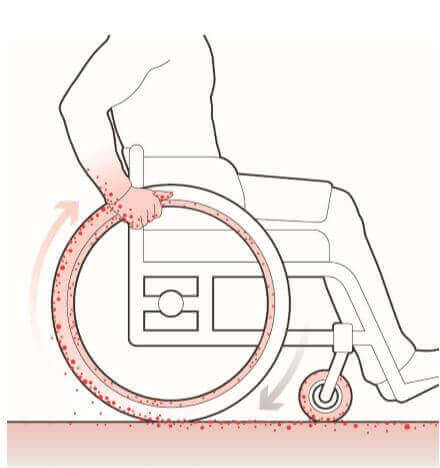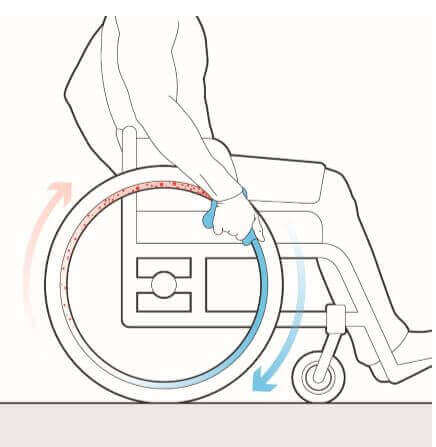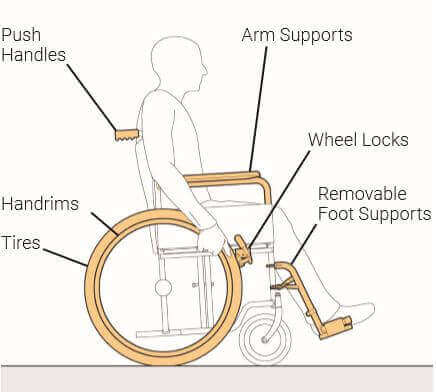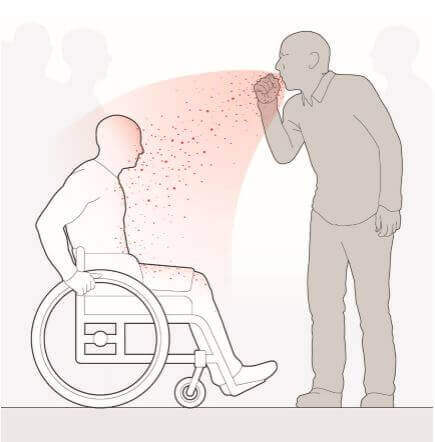Greetings from Beneficial Designs. My name is Peter Axelson. I am a wheelchair user, designer, and engineer, and I am reaching out today with important information regarding COVID-19 precautions to be taken by wheelchair users.
In the 1970s, James Robb, MD, was one of the first molecular virologists in the world to study coronaviruses. Dr. Robb has shared an important email correspondence on how this virus can spread. According to Robb, the virus spreads in droplets through coughing and sneezing. He cautions that surfaces where these droplets land are infectious for about a week, on average. It's important to remember that direct contact with an infected surface does not guarantee the spread of infection, so long as you continuously wash your hands and keep them away from your face.
If you push a manual wheelchair or use other types of assistive technology (AT), there are unique precautions you should take related to hand washing. COVID-19 can survive on the surfaces of your wheelchair or AT which you come in frequent contact with, such as the handrims. Any virus that might be on your hands is transferred to your handrims as you push your wheelchair.
Clean Hands
Washing your hands is incredibly important. Wash your hands with soap for 10-20 seconds and/or use a greater-than 60% alcohol-based hand sanitizer whenever you return home from ANY activity that involves locations where other people have been. Using a fingernail brush is a good idea for those of us who have really rough skin from pushing our wheelchairs for so many years.

Tires transfer the virus to the hands and your hands transfer the virus to the handrims.
I Have been a manual wheelchair user for over 40 years, since I broke my back at the U.S. Air Force Academy during a training exercise. Because my hands are always touching the handrims of my wheelchair, I use anti-bacterial wet wipes to clean my hands before eating. Using hand wipes prior to meals, regardless of where I am, has reduced the amount of colds and flu infections I have contracted over the past 20 years. I generally do not touch the tires of my wheelchair, as I use flexible ergonomic handrims which provide a great grip without requiring hand-to-tire contact.
In addition, if you push on your tires, you are basically touching everywhere you have rolled. Wearing gloves when pushing is another option for keeping your hands cleaner. However, if you wear gloves you might need to think about where you set them, as they may no the infected with a virus. It is also likely that the inside of your gloves may become infected unless you always wash your hands before putting the gloves on.
Clean Wheelchair
Washing the surfaces of your wheelchair is an important practice. All surfaces that we touch could potentially have viruses on them. The handrims and tires of your wheelchair are solid surfaces. At home, when I wash my hands, I have two washcloths or anti-bacterial wipes available. After I wet my hands, apply soap, and then wash my hands, I get two washcloths or paper towels wet with some anti-bacterial soap and push my wheelchair around the house, sliding the washcloths on the handrims as I go. I push my chair about 20 feet (6 meters), or spin around in circles if I am in a public bathroom. Pushing 20 feet wipes the handrims three times. It can be a bit tricky to learn how to do this. You can have someone slowly push you to make it easier. This allows me to clean the handrims of my wheelchair.

Pushing the chair forward and applying an anti-bacterial soap will clean your handrims.
I recommend a similar technique for cleaning your wheels: push the wheelchair around with the washcloths on the tires. While I'm at it, I also wipe the other surfaces that I regularly touch on my wheelchair, including the wheel locks and the frame in front of my seat cushion. If you have arm supports, push handles, or removable foot supports, those should be cleaned as well. If you use a power wheelchair, disinfect your joystick, controls, and anything else that you regularly touch on your chair. Remember that many plastics could react poorly to a cleaner containing bleach.

Make sure to wipe down all surfaces of your wheelchair that you or others regularly touch.
As long as you wash your hands with sanitizer or wet wipes before getting into your wheelchair, it can be helpful if someone else washes your tires and handrims while you are not using the chair. I also regularly clean grab bars and other surfaces that I touch in my home when making transfers into or out of my wheelchair. If you do not clean your wheelchair or AT after washing your hands, you will reinfect your hands with the virus that might be on the handrims or other surfaces that you touch. In case you might have touched part of your uncleaned wheelchair or AT during the cleaning process, it might be a good idea to wash your hands again afterwards.
Social Distance
There is also the matter of social distancing. Because wheelchair users tend to sit lower than most people that are standing, we can experience more exposure to saliva droplets when talking to people taller than us. Many medical professionals have recommended observing a minimum of 6 feet (2 meters) of distance to those around you to alleviate this risk.

Wheelchair users sit lower and are more vulnerable to infected saliva droplets and aerosols.
You may also consider wearing some type of face mask to protect yourself from getting "sprayed" by people talking to you. Medical face masks are in high demand right now, and not easy to get hold of. I have a face mask that I wear skiing on really cold days; it would catch any unintentional spraying of saliva from someone's speech, sneeze, or cough. A virus could go through the mask since it is not an N95-rated mask, but my ski mask might be better than no protection at all. A face mask would also keep me from touching my mouth and nose, further preventing infection. It is important to limit hand-to-face contact as much as possible. Personally, I keep a cup of paint-stir sticks that I use to scratch my face when I have an itch.
To Recap
- Wash your hands often and wipe them with anti-bacterial wipes just before and after you eat.
- Wipe down your wheelchair (especially handrims, tires, and joysticks) or other AT with a sanitized cloth or anti-bacterial wipe.
- Observe a minimum of 6 feet (2 meters) of distance from others in social interactions, and consider the benefits of wearing a face mask, medical or otherwise.
We have a responsibility to ourselves and others to act in accordance with medical authority suggestions for preventing the spread of disease. By following these additional suggestions, as wheelchair users, we can all do our best to limit the spread of the virus and enable healthier environments for ourselves and those who we come in contact with. I hope this advice can be of use and provide additional comfort in knowing the specific precautions that can be taken by wheelchair and AT users. This is an extraordinary trial we are going through. These precautions mean that it will take you much longer to practice appropriate hygiene than it will for able-bodied people. If you are alive and pushing a manual wheelchair independently, you have already proven to yourself that you have the perseverance to continue living your life. Do not give up because of a virus. Just because you use a wheelchair and there's a new virus spreading around, you do not need to live your life in fear. Be courageous, and push forward.
About the Author
Peter Axelson MSME, ATP, RET. Manual wheelchair user and leader of Beneficial Designs.
Most of the stories here on LiveQuickie.com were submitted by readers. Do you have a story to tell? We'd love to hear it. Submit your story here.